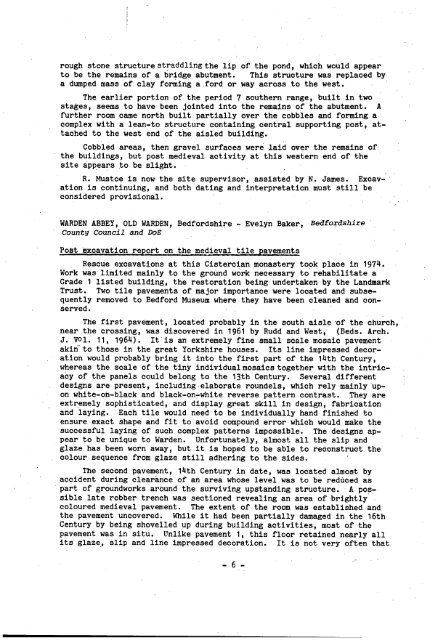Untitled - Council for British Archaeology
Untitled - Council for British Archaeology
Untitled - Council for British Archaeology
Create successful ePaper yourself
Turn your PDF publications into a flip-book with our unique Google optimized e-Paper software.
ough stone structure straddling the lip of the pond, which would appear<br />
to be the remains of a bridge abutment. This structure was replaced by<br />
a dumped mass of clay <strong>for</strong>Ming a <strong>for</strong>d or way across to the west.<br />
The earlier portion of the period 7 southern range, built in two<br />
stages, seems to have been jointed into the remains of the abutment. A<br />
further room came north built partially over the cobbles and <strong>for</strong>ming a<br />
complex with a lean-to structure containing central supporting post, attached<br />
to the west end of the aisled building.<br />
Cobbled areas, then gravel surfaces were. laid over the remains of<br />
the buildings, but post medieval activity at this western end of the<br />
site appears to be slight.<br />
R. Mustoe is now the site supervisor, assisted by N. James. Excavation<br />
is continuing, and both dating and interpretation must still be<br />
considered provisional.<br />
WARDEN ABBEY, OLD WARDEN, Bed<strong>for</strong>dshire - Evelyn Baker, Bed<strong>for</strong>dshire<br />
County <strong>Council</strong> and DoE<br />
PoSt excavation re ort on the medieval tile avements<br />
Rescue excavations at this Cistercian monastery took place in 1974.<br />
Work was limited mainly to the ground work necessary to rehabilitate a<br />
Grade 1 listed building, the restoration being undertaken by the Landmark<br />
Trust. Two tile pavements of major importance were located and subsequently<br />
removed to Bed<strong>for</strong>d Museum where they have been cleaned and conserved.<br />
The first pavement, located probably in the south aisle-of the church,<br />
near the crossing, was discovered in 1961 by Rudd and West, (Beds. Arch.<br />
J. Vol. 11, 1964). It is an extremely fine small scale mosaic pavement<br />
akin-to those in the great Yorkshire houses. Its line impressed decoration<br />
would probably bring it into the first part of the 14th CenturY,<br />
whereas the scale of the tiny individualmosaics together with the intricacy<br />
of the panels could belong to the 13th Century. Several different<br />
designs are present, including,elaborate roundels, which rely mainly 'upon<br />
white-oh-black and black-on-white reverse pattern contrast. They are<br />
extremely sophisticated, and display great skill in design, fabrication<br />
and laying. Each tile would need to be individually hand finished to<br />
ensure exact shape and fit to avoid compound error which would make the<br />
successful laying of such complex patterns impossible. The designs appear<br />
to be unique to Warden. Un<strong>for</strong>tunately, almost all the slip and<br />
glaze has been worn away, but it is hoped to be able to reconstruct the<br />
colour sequence from glaze still adhering to the sides.<br />
The second pavement, 14th Century in date, was located almost by<br />
accident during clearance of an area whose level was to be redimed as<br />
part of groundworks around the surviving upstanding structure. A possible<br />
late robber trench was sectioned revealing an area of brightly<br />
coloured medieval pavement. The extent of the room was established and<br />
the pavement uncovered. While it had been partially damaged in the 16th<br />
Century by being shovelled up during building activities, most of the<br />
pavement was in situ. Unlike pavement 1, this floor retained nearly all<br />
its glaze, slip and line impressed decoration. It is not very often that<br />
-6-

















